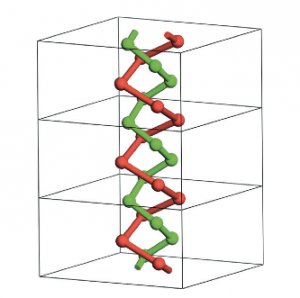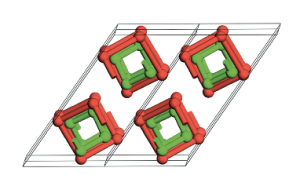
Martin Mayo, Hugh Glass, Andrew J. Morris.
LIBs are the rechargeable battery of choice for electric vehicles and portable electronic devices. There is substantial interest in enhancing the capacity of LIBs, driven by the economic and environmental advantages of increasing the range of electric vehicles, and enabling longer-life portable electronic devices. The traditional anode is composed of graphite but recently silicon has been proposed as an alternative which has a theoretical capacity some ten-times larger. Silicon anodes are not fully understood however and suffer from large volume expansion on charge and hysteresis on charge cycling. Phosphorous is another such candidate for high-capacity anodes due to its multiple allotropes (white, red and black phosphorus), its ability to make Hittorf-chains and novel structures when mixed with lithium.[1]
The creation of new materials is both difficult and expensive. It is very difficult to “see” the structure of these materials over the length scales that they work and very expensive to create prototype materials to test. Whilst experimental physics can use x-rays, high-energy electrons or neutrons to infer the structure of these materials, this inference is made  much more robust when combined with theoretical predictions of the kinds of structures that can be formed. In a computer we use quantum mechanical calculations to simulate the results of these kinds of experiments, helping to understand materials and suggest new materials with the kind of properties desired. The theoretical prediction of even very simple structures has, until recently, been out of bounds due to the large number of possible atomic arrangements. The ab initio random structure searching method (AIRSS) [2] uses a stochastic approach to suggest different structural configurations of atoms within a material. By searching over a range of stoichiometries it is possible to model how a battery is charged as we can predict the structural changes of the electrodes as a charging potential is applied. Using this knowledge it is possible to perform further theoretical analysis such as NMR and EELS (electron energy loss) spectroscopies and predict charge and discharge voltages.
much more robust when combined with theoretical predictions of the kinds of structures that can be formed. In a computer we use quantum mechanical calculations to simulate the results of these kinds of experiments, helping to understand materials and suggest new materials with the kind of properties desired. The theoretical prediction of even very simple structures has, until recently, been out of bounds due to the large number of possible atomic arrangements. The ab initio random structure searching method (AIRSS) [2] uses a stochastic approach to suggest different structural configurations of atoms within a material. By searching over a range of stoichiometries it is possible to model how a battery is charged as we can predict the structural changes of the electrodes as a charging potential is applied. Using this knowledge it is possible to perform further theoretical analysis such as NMR and EELS (electron energy loss) spectroscopies and predict charge and discharge voltages.
[1] “Inorganic Double Helix Structures of Unusually Simple Li-P Species”, Alexander S. Ivanov, Andrew J. Morris, Konstantin V. Bozhenko, Chris J. Pickard and Alexander I. Boldyrev, [Angewandte Chemie 51 33, 8330-8333 (2012)]
[2] C.J. Pickard, and R.J. Needs , Phys. Rev. Lett. 97, 045504 (2006)
